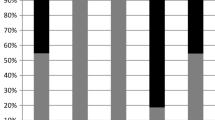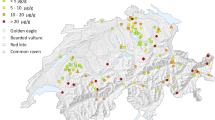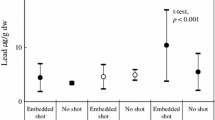Abstract
Red-winged blackbirds (Agelaius phoeniceus), brown-headed cowbirds (Molothrus ater), common grackles (Quiscalus quiscula), mallards (Anas platyrhynchos), northern bobwhites (Colinus virginianus), and eastern screech-owls (Otus asio) were poisoned with a concentration of lead (Pb) acetate in the diet which was increased by 60% each week until half of the birds in each treatment group died; surviving birds and all control birds except screech-owis were then killed by euthanasia. An additional group of mallards was poisoned with Pb shot. The gizzards of mallards poisoned either way usually were stained with bile; some of these birds also had proventricular impaction. Most poisoned birds of the other species were emaciated but lacked other gross lesions caused by Pb poisoning. In birds other than mallards, Pb poisoning could not be diagnosed without histological or hematological examinations or analysis of tissues. Poisoned birds of all six species could be reliably separated from control birds by an increase in the protoporphyrin concentrations in the blood and by a decrease in the activity of delta-aminolevulinic acid dehydratase (ALAD) in red blood cells. Hepatic iron (Fe) concentrations varied so much among individual birds that even though median hepatic Fe concentrations increased in poisoned birds, hepatic Fe concentrations were not useful in identifying poisoned birds. Renal intranuclear inclusion bodies occurred in 83% of all birds dying from Pb poisoning. Nephrosis, myocardial necrosis, and arterial fibrinoid necrosis were occasionally present. Median hepatic Pb concentrations varied from 20 ppm (wet wt) in male red-winged blackbirds to 111 ppm in female northern bobwhites. Median renal Pb concentrations varied from 22 ppm in redwinged blackbirds to 190 ppm in female northern bobwhites. Hepatic and renal Pb concentrations varied substantially among birds within each species. Median hepatic and renal Pb concentrations of birds that died were not statistically different (p > 0.05) from those of birds that were killed. Lead shot and Pb acetate affected mallards similarly.
Similar content being viewed by others
References
Abdulla M, Svensson B, Haeger-Aronsen B, Mathur A, Wallenius K (1978) Effect of age and diet on delta-aminolevulinic acid dehydratase in red blood cells. Enzyme 23:170–175
Barrett MW, Karstad LH (1971) A fluorescent erythrocyte test for lead poisoning in waterfowl. J Wildl Manage 35:109–119
Bellrose FC (1959) Lead poisoning as a mortality factor in waterfowl populations. Ill Nat Hist Bull 27:235–288
Beyer WN, Pattee OH, Sileo L, Huffman DJ, Mulhern BM (1985) Metal contamination in wildlife living near two zinc smelters. Environ Pollut, Series A Ecol 38:63–86
Birkhead M (1982) Lead poisoning in the mute swan. In: Osborn D (ed) Metals in animals. Natural Environment Research Council, Cambridge, Great Britain, pp 16–24
Buren HB, Siegel AL (1971) Improved method for measurement of delta-aminolevulinic acid dehydratase activity of human erythrocytes. Clin Chem 17:1038–1041
Caue PP, Kowalczyk DF, Dein FJ, Hartman FE (1982) Effect of hunters switch from iead to steei shot on potential for oral lead poisoning in ducks. J Am Vet Med Assoc 181:1299–1301
Chupp NR, Dalke PD (1964) Waterfowl mortality in the Coeur d'Alene River Valley, Idaho. J Wildl Manage 28:692–702
Coburn DR, Metzler DW, Treichler R (1951) A study of absorption and retention of lead in wild waterfowl in relation to clinical evidence of lead poisoning. J Wildl Manage 15:186–192
Conover WJ (1980) Practical nonparametric statistics. 2nd edn, John Wiley & Sons, New York, 493 pp
Del Bono G, Braca G (1973) Lead poisoning in domestic and wild ducks. Avian Pathol 2:195–209
Franson JC, Custer TW (1982) Toxicity of dietary lead in young cockerels. Vet Hum Toxicol 24:421–423
Franson JC, Haramis GM, Perry MC, Moore JF (1986) Blood protoporphyrin for detecting iead exposure in canvashacks. In: Feierabend JS, Russell AB (eds) Lead poisoning in wild waterfowl-A workshop. National Wildlife Federation, Washington, DC, pp 32–37
Getz LL, Best LB, Prather M (1977) Lead in urban and rural song birds. Environ Pollut 12:235–238
Grue CE, Hoffman DJ, Beyer WN, Franson LP (1986) Lead concentrations and reproductive success in European. starlingsSturnus vulgaris nesting within roadside verges. Environ Pollut, Series A Ecol 42:157–182
Grue CE, O'Shea TJ, Hoffman DJ (1984) Lead concentrations and reproduction in highway-nesting barn swallows. Condor 86:383–389
Hoffman DJ, Pattee OH, Wiemeyer SN, Mulhern B (1981) Effects of lead shot ingestion on δ-aminolevulinic acid dehydratase activity, hemoglobin concentration, and serum chemistry in bald eagles. J Wildl Dis 17:423–431
Howard DR, Penumarthy L (1979) Lead poisoning in Canada geese: A case report. Vet Hum Toxicol 21:243–244
Hunter BF, Rosen MN (1965) Occurrence of lead poisoning in a wild pheasant (Phasianus colchicus). Calif Fish Game 51:207
Hutton M (1983) The effects of environmental lead exposure andin vitro zinc on tissue δ-aminolevulinic acid dehydratase in urban pigeons. Comp Biochem Physiol 2:441–446
Janssen DL, Robinson PT, Ensley PK (1979) Lead toxicosis in three captive avian species. Am Assoc Zoo Vet Annu Proc: 40–42
Jubb KVF, Kennedy PC (1970) Pathology of domestic animals. 2nd edn, Vol. 1. Academic Press, New York, 593 pp
Kaiser TE, Reichel WL, Locke LN, Cromartie E, Krynitsky AJ, Lamont TG, Mulhern BM, Prouty RM, Stafford CJ, Swineford DM (1980) Organochlorine pesticide, PCB, and PBB residues and necropsy data for bald eagles from 29 states-1975–77. Pestic Monit J 13:145–149
Karstad L (1971) Angiopathy and cardiopathy in wild waterfowl from ingestion of lead shot. Conn Med 35:355–360
Kendall RJ, Veit HP, Scanion PF (1981) Histological effects and lead concentrations in tissues of adult male ringed turtle doves that ingested lead shot. J Toxicol Environ Health 8:649–658
Locke LN, Bagley GE, Irby HD (1966) Acid-fast intranuclear inclusion bodies in the kidneys of mallards fed lead shot. Bull Wildl Dis Assoc 2:127–131
Locke LN, Bagley GE, Young LT (1967) The ineffectiveness of acid-fast inclusions in diagnosis of lead poisoning in Canada geese. Bull Wildl Dis Assoc 3:176
Longcore JR, Locke LN, Bagley GE, Andrews R (1974) Significance of lead residues in mallard tissues. U.S. Fish and Wildlife Service Special Scientific Report No. 182
MacDonald JW, Randall CJ, Ross HM, Moon GM, Ruthven AD (1983) Lead poisoning in captive birds of prey. Vet Rec 113:65–66
Mudge GP (1983) The incidence and significance of ingested lead pellet poisoning in British wildfowl. Biol Conserv 27:333–372
Pattee OH, Hennes SK (1983) Bald eagles and waterfowl: The lead shot connection. Trans N Amer Wildl and Natur Resour Conf 48:230–237
Pattee OH, Wiemeyer SN, Mulhern BM, Sileo L, Carpenter JW (1981) Experimental lead-shot poisoning in bald eagles. J Wildl Manage 45:806–810
Reiser MH, Temple SA (1980) Effects of chronic lead ingestion on birds of prey. In: Cooper JE, Greenwood AG (eds) Recent advances in the study of raptor diseases. Chiron, Keighly, England, pp 21–25
Roscoe DE, Nielsen SW, Lamola AA, Zuckerman D (1979) A simple quantitative test for erythrocytic protoporphyrin in lead-poisoned ducks. J Wildl Dis 15:127–136
Sanderson GC, Bellrose FC (1986) A review of the problem of lead poisoning in waterfowl. Illinois Natural History Survey Special Publication 4. Champaign, Illinois, 34 pp
Scanion PF, Stotts VD, Oderwald RG, Dietrick TJ, Kendall RJ (1980) Lead concentrations in livers of Maryland waterfowl with and without ingested lead shot present in gizzards. Bull Environ Contam Toxicol 25:855–860
Sileo L, Jones RN, Hatch RC (1973) The effect of ingested lead shot on the electrocardiogram of Canada geese. Avian Dis 17:308–313
Simpson VR, Hunt AE (1979) Chronic lead poisoning in a herd of mute swans. Environ Pollut 18:187–202
Szymczak MR, Adrian WJ (1978) Lead poisoning in Canada geese in southwest Colorado. J Wildl Manage 42:299–306
Williams RB (1985) Biliverdin production in chickens infected with the malarial parasitePlasmodium gallinaceum. Avian Pathol 14:409–419
Zook BC, Sauer RM, Garner FM (1972) Lead poisoning in captive wild animals. J Wildl Dis 8:264–272
Author information
Authors and Affiliations
Rights and permissions
About this article
Cite this article
Beyer, W.N., Spann, J.W., Sileo, L. et al. Lead poisoning in six captive avian species. Arch. Environ. Contam. Toxicol. 17, 121–130 (1988). https://doi.org/10.1007/BF01055162
Received:
Revised:
Issue Date:
DOI: https://doi.org/10.1007/BF01055162




